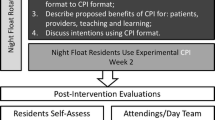Abstract
OBJECTIVE: To assess the importance to patients of various aspects of bedside interactions with physician teams.
DESIGN: Cross-sectional survey.
SETTING: VA hospital.
PATIENTS: Ninety-seven medical inpatients.
INTERVENTION: Survey of 44 questions including short answer, multiple choice, and Likert-type questions.
MEASUREMENTS AND MAIN RESULTS: Data analysis included descriptive statistics. The sample was predominantly male, with a mean age of 62. Overall satisfaction with the hospital experience and with the team of doctors were both high (95% and 96% reported being very or mostly satisfied, respectively). Patients reported learning about several issues during their interactions with the teams; the 3 most highly rated areas were new problems, tests that will be done, and treatments that will be done. Most patients (76%) felt that their teams cared about them very much. Patients were made comfortable when the team showed that they cared, listened, and appeared relaxed (reported by 63%, 57%, and 54%, respectively). Patients were made uncomfortable by the team using language they did not understand (22%) and when several people examined them at once (13%). Many (58%) patients felt personally involved in teaching. The majority of patients liked having medical students and residents involved in their care (69% and 64%, respectively).
CONCLUSION: Patients have much to teach about what is important about interacting with physician teams. Although patients’ reactions to team interactions are generally positive, patients are different with respect to what makes them comfortable and uncomfortable. Taking their preferences into account could improve the experience of being in a teaching hospital.
Similar content being viewed by others
References
Nair BR, Coughlan JL, Hensley MJ. Student and patient perspectives on bedside teaching. Med Educ. 1997;31:341–6.
Committee on Quality Health Care in America, Institute of Medicine. Crossing the Quality Chasm: A New Health System for the 21st Century. Washington, DC: National Academies Press; 2000.
Linfors EW, Neelon FA. Sounding boards. The case of bedside rounds. N Engl J Med. 1980;303:1230–3.
Lehmann LS, Brancati FL, Chen M, Roter D, Bods AS. The effect of bedside case presentations on patients’ perceptions of their medical care. N Engl J Med. 1997;336:1150–5.
Simons RJ, Baily RG, Zelis R, Zwillich CW. The physiologic and psychological effects of the bedside presentation. N Engl J Med. 1989;321:1273–5.
Fletcher KE, Furney SL, Stern DT. Patients speak: what’s really important about bedside interactions with physician teams. J Gen Intern Med. 2003;18(suppl 1):232. Abstract.
Glaser BG, Strauss AL. The Discovery of Grounded Theory: Strategies for Qualitative Research. Chicago, IL: Aldine Publishing Company; 1967;101–15.
Matthews DA, Feinstein AR. A new instrument for patients’ ratings of physician performance in the hospital setting. J Gen Intern Med. 1989;4:14–22.
Rodgers HD, Carline JD, Paauw DS. Examination room presentations in general internal medicine clinic: patients’ and students’ perceptions. Acad Med. 2003;78:945–9.
Wang-Cheng RM, Barnas GP, Sigmann P, Riendl PA, Young MJ. Bedside case presentations: why patients like them but learners don’t. J Gen Intern Med. 1989;4:284–7.
Anderson LA, Dedrick RF. Development of the Trust in Physician scale: a measure to assess interpersonal trust in patient-physician relationships. Psychol Rep. 1990;67:1091–100.
LaCombe MA. On bedside teaching. Ann Intern Med. 1997;126:217–20.
Ramani S, Orlander JD, Strunin L, Barber TW. Whither clinical teaching? A focus-group study of clinical teachers. Acad Med. 2003;78:384–90.
Author information
Authors and Affiliations
Corresponding author
Additional information
The authors have no conflicts of interest to report.
Dr. Fletcher was a Robert Wood Johnson/Veterans Affairs Scholar while working on this project.
Rights and permissions
About this article
Cite this article
Fletcher, K.E., Rankey, D.S. & Stern, D.T. Bedside interactions from the other side of the bedrail. J GEN INTERN MED 20, 58–61 (2005). https://doi.org/10.1111/j.1525-1497.2005.40192.x
Accepted:
Issue Date:
DOI: https://doi.org/10.1111/j.1525-1497.2005.40192.x




